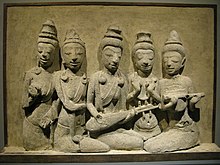
The Mon are an ethnic group who inhabit Lower Myanmar's Mon State, Kayin State, Kayah State, Tanintharyi Region, Bago Region, the Irrawaddy Delta, and several areas in Thailand. The native language is Mon, which belongs to the Monic branch of the Austroasiatic language family and shares a common origin with the Nyah Kur language, which is spoken by the people of the same name that live in Northeastern Thailand. A number of languages in Mainland Southeast Asia are influenced by the Mon language, which is also in turn influenced by those languages.

Wat Phra Kaew, commonly known in English as the Temple of the Emerald Buddha and officially as Wat Phra Si Rattana Satsadaram, is regarded as the most sacred Buddhist temple in Thailand. The complex consists of a number of buildings within the precincts of the Grand Palace in the historical centre of Bangkok. It houses the statue of the Emerald Buddha, which is venerated as the country's palladium.
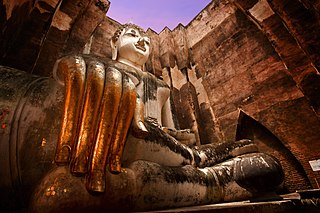
Sukhothai Historical Park covers the ruins of Sukhothai, literally 'dawn of happiness', capital of the Sukhothai Kingdom in the 13th and 14th centuries, in north central Thailand. It is near the city of Sukhothai, capital of Sukhothai Province.

Dvaravati was an ancient Mon political principality from the 6th century to the 11th century that was located in the region now known as central Thailand. It was described by Chinese pilgrims in the middle of the 7th century as a Buddhist kingdom named To-lo-po-ti situated to the west of Isanapura (Cambodia) and to the east of Sri Ksetra (Burma). Dvaravati also refers to a culture, an art style, and a disparate conglomeration of principalities of Mon people. Archaeological research over the past two decades or so has revealed the presence of a "Proto-Dvaravati" period which spans the 4th to 5th centuries, and perhaps earlier.

Thai art refers to a diverse range of art forms created in Thailand from prehistoric times to the present day, including architecture, sculpture, painting, textiles, decorative arts, crafts, ceramics, and more. While Buddhism has played a significant role in Thai art, with many sculptures and paintings depicting Buddha images and religious themes, nature, including flora and fauna, as well as mythical creatures, has been a major inspiration for Thai art, with colorful motifs appearing in various types of art forms. In contemporary Thai art, traditional works remain significant and continue to influence artists' concepts.
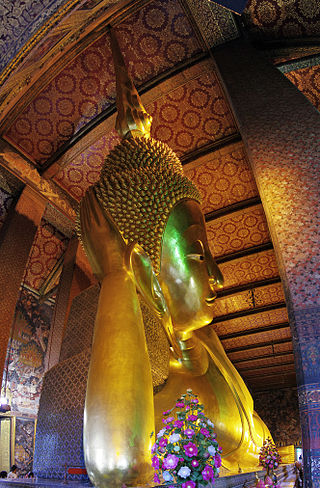
Wat Pho, also spelled Wat Po, is a Buddhist temple complex in the Phra Nakhon District, Bangkok, Thailand. It is on Rattanakosin Island, directly south of the Grand Palace. Known also as the Temple of the Reclining Buddha, its official name is Wat Phra Chetuphon Wimon Mangkhalaram Rajwaramahawihan. The more commonly known name, Wat Pho, is a contraction of its older name, Wat Photaram.

Nakhon Pathom is a city in central Thailand, the former capital of Nakhon Pathom province. One of the most important landmarks is the giant Phra Pathommachedi. The city is also home to Thailand's only Bhikkhuni temple Wat Song Thammakanlayani (วัดทรงธรรมกัลยาณี), which is also open to women from abroad.

Phra Pathommachedi or Phra Pathom Chedi is a Buddhist stupa in Thailand. The stupa is located in the Wat Phra Pathommachedi Ratcha Wora Maha Wihan (Thai: วัดพระปฐมเจดีย์ราชวรมหาวิหาร), a temple in the town center of Nakhon Pathom, Nakhon Pathom Province, Thailand. Phra Pathommachedi is the tallest stupa in the world. The top of its spire reaches 120.45 meters, with the base circumference of 235.50 meters.

Buddhism in Thailand is largely of the Theravada school, which is followed by roughly 93.4 percent of the population. Thailand has the second largest Buddhist population in the world, after China, with approximately 64 million Buddhists. Buddhism in Thailand has also become integrated with folk religion (Bon), Hinduism from millennia of Indian influence, and Chinese religions from the large Thai Chinese population. Buddhist temples in Thailand are characterized by tall golden stupas, and the Buddhist architecture of Thailand is similar to that in other Southeast Asian countries, particularly Cambodia and Laos, with which Thailand shares cultural and historical heritages. Thai Buddhism also shares many similarities with Sri Lankan Buddhism. Thailand, Cambodia, Myanmar, Sri Lanka and Laos are countries with Theravada Buddhist majorities.

The iconography of Gautama Buddha in Laos and Thailand recall specific episodes during his travels and teachings that are familiar to the Buddhists according to an iconography with specific rules. The Buddha is always represented with certain physical attributes, and in specified dress and specified poses. Each pose, and particularly the position and gestures of the Buddha's hands, has a defined meaning which is familiar to Buddhists. In other Buddhist countries, different but related iconography is used, for example the mudras in Indian art. Certain ones of these are considered particularly auspicious for those born on particular days of the week.

Wat Phra That Phanom is a Buddhist temple in the That Phanom District in the south of Nakhon Phanom Province, all within the Isan region of Thailand near the Lao border. According to local legend, the temple contains in the pagoda the Phra Uranghathat (พระอุรังคธาตุ)/Phra Ura (พระอุระ)/Buddha's breast bones. As such, it is one of the most important structures for Theravada Buddhists and the most important Buddhist site in the province, with an annual week-long festival being held in the town of That Phanom to honour the temple. These festival attract thousands of people who make pilgrimages to the shrine. In Thai folk Buddhism, Wat Phra That Phanom is a popular pilgrimage destination for those born in the year of the Monkey.

The Si Satchanalai Historical Park is a historical park in Si Satchanalai district, Sukhothai Province, northern Thailand. The park covers the ruins of Si Satchanalai and Chaliang. Si Satchanalai, which literally means "City of good people", was founded in 1250 as the second center of the Sukhothai Kingdom and as a residence of the crown prince in the 13th and 14th centuries.
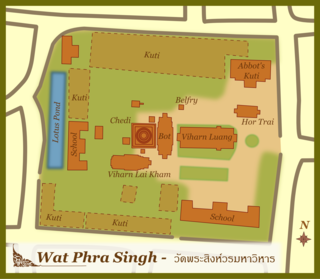
Wat Phra Singh is a Buddhist temple in Chiang Mai, northern Thailand. King Ananda Mahidol, bestowed upon it the status of Royal temple of the first grade in 1935.
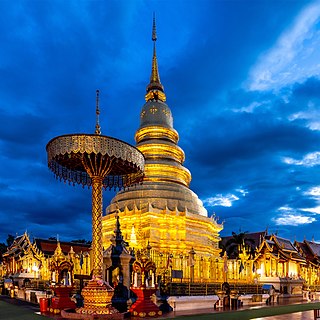
Wat Phra That Hariphunchai is a Buddhist temple (wat) in Lamphun, Thailand. The temple's origins date from the 11th century but the central stupa is thought to originate in the 9th century.
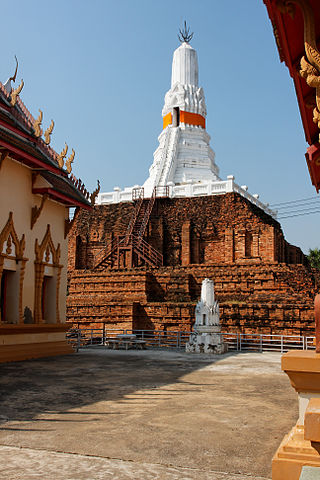
Phra Prathon Chedi is one of the oldest stupas in Thailand with the height of 50 metres (164 ft). The stupa is located in the Wat Phra Prathon Chedi Wora Viharn, a temple in Nakhon Pathom, Thailand, 3 km east of Phra Pathommachedi.
Buddhavanam is a tourism project in Nagarjuna Sagar, Telangana created by the Telangana State Tourism Development Corporation. The project was sanctioned by the Government of India viz., Integrated Development of Nagarjunasagar as part of Lower Krishna valley Buddhist circuit with a view to attract large number of domestic and foreign tourists particularly from the South-East Asian countries.

Wat Phra Si Sanphet was the holiest temple on the site of the old Royal Palace in Thailand's ancient capital of Ayutthaya until the city was completely destroyed by the Burmese in 1767, during the Burmese–Siamese War. It was the grandest and most beautiful temple in the capital and it served as a model for Wat Phra Kaew in Bangkok.

Leela attitude is an attitude of Buddha in Southeast art of which the Buddha is stepping with his right foot and his right-hand swinging and the other hand put towards to the front. The attitude is sometimes called the Walking Buddha.
Stupas in Cambodia more often referred to as chedi are steeple-shaped mausoleums holding the bones and ashes of the deceased placed throughout the grounds of a pagoda, typically found in Cambodia, usually financed by wealthier believers for themselves and their relatives. While the prang derived from the Indian shikhara prototype, the chedi felt both the Indian influence, through the prototype of the stupa, especially that of Sanchi, as well as other influences, especially with the prototype stupa of Ruwanwelisaya in Ceylan, from where Theravada Buddhism also arrived.

